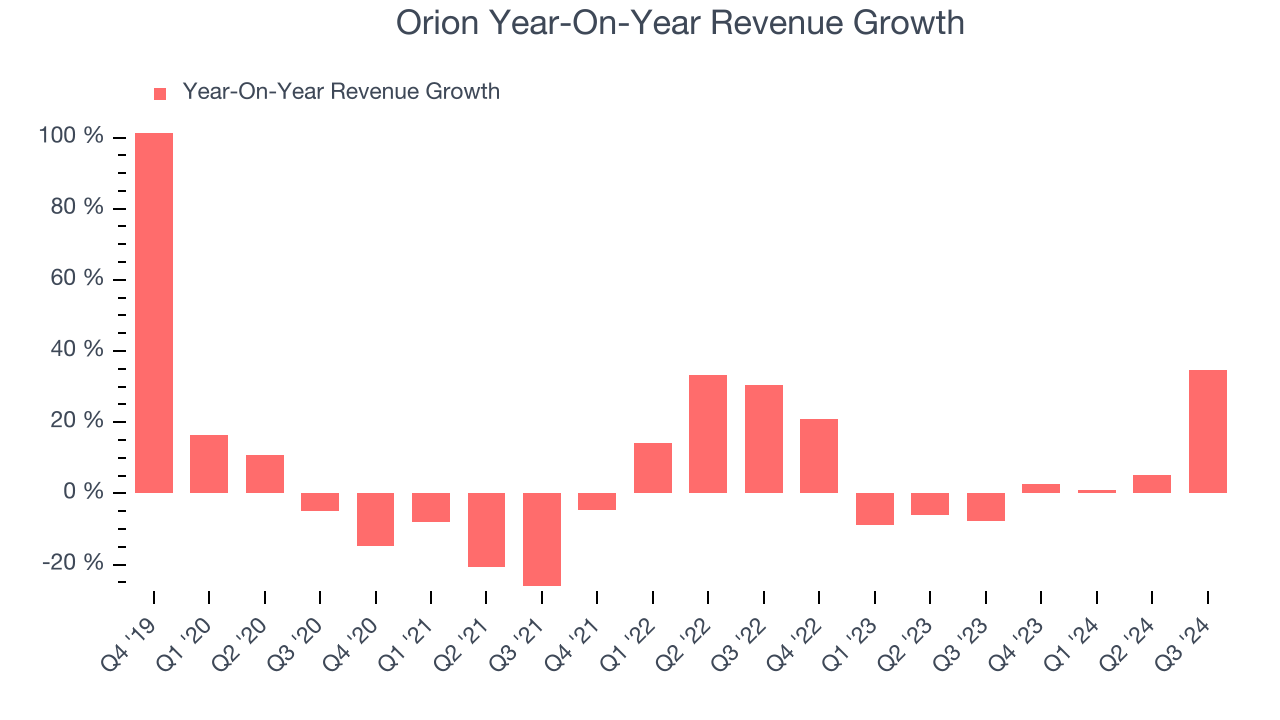
Marine infrastructure company Orion (NYSE: ORN) missed Wall Street’s revenue expectations in Q3 CY2024, but sales rose 34.5% year on year to $226.7 million. Its GAAP profit of $0.12 per share was 227% above analysts’ consensus estimates.
Is now the time to buy Orion? Find out by accessing our full research report, it’s free.
Orion (ORN) Q3 CY2024 Highlights:
- Revenue: $226.7 million vs analyst estimates of $235 million (3.6% miss)
- EPS: $0.12 vs analyst estimates of $0.04 ($0.08 beat)
- EBITDA: $15.21 million vs analyst estimates of $12.85 million (18.4% beat)
- Gross Margin (GAAP): 11.9%, in line with the same quarter last year
- Operating Margin: 3.4%, up from 1.1% in the same quarter last year
- EBITDA Margin: 6.7%, up from 1.4% in the same quarter last year
- Free Cash Flow was $31 million, up from -$18.91 million in the same quarter last year
- Backlog: $690.5 million at quarter end
- Market Capitalization: $208.4 million
“I am pleased to report that our team delivered a strong third quarter, including 35% contract revenue growth, 62% Adjusted EBITDA growth, and cash flow from operations of $35.2 million. In the beginning of the year, we said that we expected momentum to pick up in the back half of the year and that played out in the third quarter,” said Travis Boone, CEO of Orion Group Holdings.
Company Overview
Established in 1994, Orion (NYSE: ORN) provides construction services for marine infrastructure and industrial projects.
Construction and Maintenance Services
Construction and maintenance services companies not only boast technical know-how in specialized areas but also may hold special licenses and permits. Those who work in more regulated areas can enjoy more predictable revenue streams - for example, fire escapes need to be inspected every five years–. More recently, services to address energy efficiency and labor availability are also creating incremental demand. But like the broader industrials sector, construction and maintenance services companies are at the whim of economic cycles as external factors like interest rates can greatly impact the new construction that drives incremental demand for these companies’ offerings.
Sales Growth
Examining a company’s long-term performance can provide clues about its business quality. Any business can put up a good quarter or two, but the best consistently grow over the long haul. Unfortunately, Orion’s 5.1% annualized revenue growth over the last five years was tepid. This shows it failed to expand in any major way, a rough starting point for our analysis.

We at StockStory place the most emphasis on long-term growth, but within industrials, a half-decade historical view may miss cycles, industry trends, or a company capitalizing on catalysts such as a new contract win or a successful product line. Orion’s annualized revenue growth of 4.6% over the last two years aligns with its five-year trend, suggesting its demand was consistently weak. 
This quarter, Orion pulled off a wonderful 34.5% year-on-year revenue growth rate, but its $226.7 million of revenue fell short of Wall Street’s rosy estimates.
Looking ahead, sell-side analysts expect revenue to grow 17.3% over the next 12 months, an improvement versus the last two years. This projection is commendable and indicates the market thinks its newer products and services will catalyze higher growth rates.
Here at StockStory, we certainly understand the potential of thematic investing. Diverse winners from Microsoft (MSFT) to Alphabet (GOOG), Coca-Cola (KO) to Monster Beverage (MNST) could all have been identified as promising growth stories with a megatrend driving the growth. So, in that spirit, we’ve identified a relatively under-the-radar profitable growth stock benefitting from the rise of AI, available to you FREE via this link.
Operating Margin
Operating margin is an important measure of profitability as it shows the portion of revenue left after accounting for all core expenses–everything from the cost of goods sold to advertising and wages. It’s also useful for comparing profitability across companies with different levels of debt and tax rates because it excludes interest and taxes.
Orion was roughly breakeven when averaging the last five years of quarterly operating profits, one of the worst outcomes in the industrials sector. This result isn’t too surprising given its low gross margin as a starting point.
Analyzing the trend in its profitability, Orion’s annual operating margin decreased by 1.9 percentage points over the last five years. The company’s performance was poor no matter how you look at it. It shows operating expenses were rising and it couldn’t pass those costs onto its customers.

This quarter, Orion generated an operating profit margin of 3.4%, up 2.3 percentage points year on year. The increase was encouraging, and since its operating margin rose more than its gross margin, we can infer it was recently more efficient with expenses such as marketing, R&D, and administrative overhead.
Earnings Per Share
We track the long-term change in earnings per share (EPS) for the same reason as long-term revenue growth. Compared to revenue, however, EPS highlights whether a company’s growth was profitable.
Although Orion’s full-year earnings are still negative, it reduced its losses and improved its EPS by 35.1% annually over the last five years. The next few quarters will be critical for assessing its long-term profitability.

Like with revenue, we analyze EPS over a more recent period because it can give insight into an emerging theme or development for the business.
For Orion, its two-year annual EPS growth of 13.3% was lower than its five-year trend. We still think its growth was good and hope it can accelerate in the future.In Q3, Orion reported EPS at $0.12, up from negative $0.02 in the same quarter last year. This print easily cleared analysts’ estimates, and shareholders should be content with the results. Over the next 12 months, Wall Street is optimistic. Analysts forecast Orion’s full-year EPS of negative $0.40 will reach break even.
Key Takeaways from Orion’s Q3 Results
We were impressed by how significantly Orion blew past analysts’ EPS expectations this quarter. We were also excited its EBITDA outperformed Wall Street’s estimates. On the other hand, its revenue missed. Overall, we think this was a solid quarter with some key areas of upside. The stock traded up 16.2% to $6.30 immediately after reporting.
Orion had an encouraging quarter, but one earnings result doesn’t necessarily make the stock a buy. Let’s see if this is a good investment. If you’re making that decision, you should consider the bigger picture of valuation, business qualities, as well as the latest earnings. We cover that in our actionable full research report which you can read here, it’s free.






